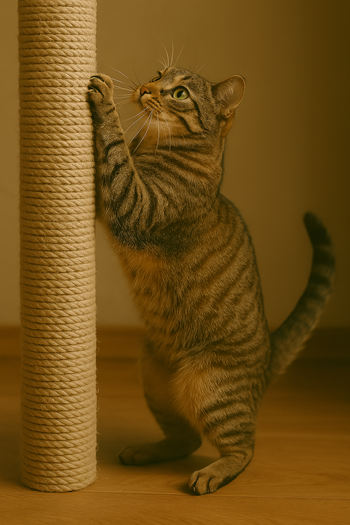
Do you hear it, that rhythmic scratch, scratch, scratch down the side of your new sofa? Why is Fluffy Sue destroying new furniture when she has that obscenely expensive, color-coordinated, carpet-covered scratching post standing unused half a room away? There are two reasons. One is that she is trying to leave her mark on the furniture to claim it as her property/territory. The other is that she is trying to loosen irritating old nail sheaths so new nails can grow.
What’s an owner to do? First, trim the cat’s nails every two to three weeks to keep them relatively blunt. Second, provide a scratching post covered with a rough material (sisal is ideal but rope, starched burlap or a tree stump will also suffice) that is at least three feet tall. Make sure it has a wide, sturdy base and won’t tip over, even when climbed on or attacked by the cat. A short or rickety post will be of no use to him, and therefore will be rejected in favor of non-tipping furniture. Keep the post interesting by sprinkling it with catnip every two weeks. Draw the cat’s attention to the post by playing interactive games with him near it. Be sure to place the post near your cat’s favorite resting place because the urge to scratch is strongest upon awakening. Don’t think that declawing will be the answer to your prayers. This surgical amputation can shake your cat’s confidence to the point where he may stop using the litter box, become a biter or start hiding in dark, out-of-the-way places to avoid social interactions. Declawing is a drastic, irreversible solution that should be left as a last resort.
Dealing With Cat Acne
You may notice that your cat has a dirty chin – little black spots that look like acne. Simply put, it is acne. And it can be quite painful, so you should take steps to get it cured as soon as possible.
Though you might want to check with your veterinarian, who can provide you with some medicine, you might want to try this first: Clean the area with hydrogen peroxide by pouring some on a clean white washcloth and sponging off the chin. You’ll probably need to do this twice a day for a week or so. Next, look at the food dishes: how often do you clean them? Are they plastic? Are they very deep? Cat food dishes should be cleaned daily, particularly if you are feeding canned food. Plastic dishes may aggravate the acne, and deep food bowls definitely will.
Provided by ASPCA Companion Animal Services
Related Articles & Free Email Newsletter Sign Up
How Playing with Your Cat Helps Them
Why a Cat Has This or Does That
Why Your Dog Pants and How it Helps Him




Comment here